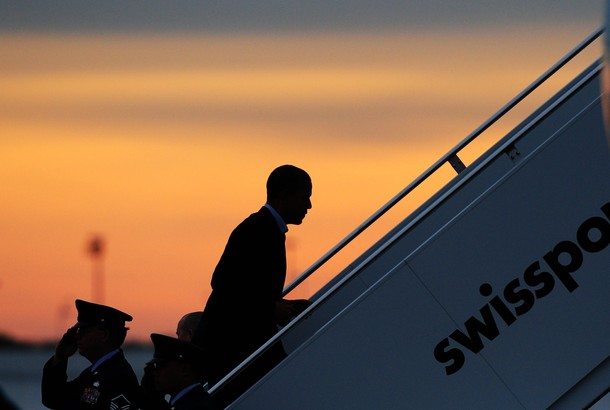President Barack Obama will unveil a revised US military strategy on Thursday designed to reflect fiscal constraints and a greater focus on the potential threat posed by a rising China, officials said.
The plan calls for confronting possible challenges from Iran and China with air and naval power while shifting away from counter-insurgency campaigns requiring large ground forces, officials and analysts said.
The “defense strategic review” is supposed to set out an approach for the US military in a more frugal era, as Obama’s administration prepares for more than $450 billion in defense cuts over the next ten years.
In a politically-charged election year, US officials have sought to portray the president as taking a careful approach to defense spending, with the Pentagon insisting any reductions will be informed by a review of military strategy.
The review argues for a smaller, agile force that will expand the military’s role in Asia while maintaining a strong naval presence in the Middle East, a defense official, who spoke on condition of anonymity, told AFP.
Under the plan, the American military would be prepared to deny any attempt by Iran to disrupt vital oil routes in the Gulf and to counter any effort by China to dominate international waters in the South China Sea, the official said.
Counter-insurgency operations, like those in Iraq and Afghanistan, will receive a lower priority under the new plan, officials said, enabling the administration to scale back the size of the Army and Marine Corps.
“It appears the Obama strategy will be to focus mainly on containing Iran and China. Therefore a combination of force deployments and arms sales in the Persian Gulf region and the western Pacific will be the centerpiece of the strategy,” said analyst Loren Thompson of the Lexington Institute.
The review reinforces what defense officials have already signaled — that funds will flow to aircraft and ships while the Army and Marine Corps will be downsized after having expanded during a decade of protracted ground wars in Afghanistan and Iraq.
“As the United States shifts its emphasis to the Pacific, ground forces will matter less, and the combination of naval and land-based air power will matter more,” said Thompson, whose institute has ties to defense firms.
Washington’s focus on Asia is fueled by concerns over China’s growing navy and arsenal of anti-ship missiles, which US officers believe potentially jeopardizes America’s military power in the Pacific.
Although the Pentagon will not say so openly, the administration appears ready to place more importance on the Asia-Pacific region at the expense of the Middle East, said Stephen Biddle, a senior fellow at the Council on Foreign Relations.
“It sure looks clear that the administration wants to put more emphasis on the Pacific relative to the Middle East,” Biddle said.
Previous presidents have attempted a similar change in course but “the Middle East has tended to get a lot of emphasis because things happen there that drag us in,” he said.
US defense officials also said the strategy review likely will pave the way for reducing the military’s footprint in Europe, by eliminating at least one brigade, or about 3,500 troops.
The strategy is also expected to discard the doctrine that the American military had to be prepared to fight two wars at the same time, an idea long debated inside the Pentagon, officials said.
Instead, the United States would be ready to fight one war while waging a holding operation elsewhere to stave off a second threat.
Before 2001, the Pentagon had prepared to fight two wars simultaneously but commanders faced a shortage of manpower in the conflicts in Afghanistan and Iraq.
The strategic review comes ahead of the proposed defense budget for 2013 due to be released in coming weeks, which is expected to call for delays in some weapons programs, including slowing the pace of production for the troubled F-35 fighter jet.
Perhaps the biggest dilemma facing the Pentagon is the ballooning cost of pay and benefits for service members and veterans, which is eating up an increasing share of the military’s budget.
Out of an annual defense budget of nearly $700 billion, military salaries, health care and pensions account for an estimated $181 billion.
Politicians are loathe to touch the sensitive issue given the revered role of the all-volunteer force, but analysts say at some point the government will be faced with a stark decision between buying weapons or paying out benefits.










